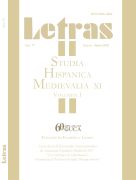Trotaconventos at the crossroads of orality and writing : the language-disguise
Keywords:
Trotaconventos, Coexistence of Oral and Written Culture, Episode of Da. Garoza, Recitation and Reading AloudAbstract
The episode of Da. Garoza stands out for being among those who have aroused greater interest among the scholars of the Libro de buen amor. But it can be proven that the aspects most often dealt with are those typical of the culture of the schools. The present work will focus, therefore, on the traces of an oral culture that still coexisted and interacted with writing, and attending, particularly, to the construction of the character of Trotaconventos. It will address formal aspects such as the constitution of the debate through narratives and the transformations of the duplicated portraits; as to the content, we will analyze the meaning of the fables in the mouth of the procuress; questions regarding the use of language and its intentionality will be investigated and the consequences of transmission through reading aloud and recitation will be examined.Downloads
References
BLECUA, Alberto, 2006, edición, introducción y notas, Juan Ruiz, Arcipreste de Hita, Libro de buen amor, Madrid, Cátedra.
CARRIZO RUEDA, Sofía M., 2012, “La descripción narrativizada, el debate por enxiemplos y la estructura reiterativa en el LBA. Cruces de la oralidad con la cultura escrita y el episodio de D. Garoza”, en Estudios de Literatura Medieval. Veinticinco años de la Asociación Hispánica de Literatura Medieval, editado por Antonia Martínez Pérez y Ana Baquero Escudero, Murcia, Universidad de Murcia, pp. 29-41.
GYBBON MONNYPENNY, G. M., 1988, edición, introducción y notas, Arcipreste de Hita, Libro de buen amor, Madrid, Castalia.
HART, Thomas, 2007, Allegory and other matters in the ‘Libro de Buen Amor’, Londres, Papers of the Medieval Hispanic Researh Seminar (no. 58), Department of Hispanic Studies, Queen Mary, University of London.
JOSSET, Jacques, 1981, edición, introducción y notas, Arcipreste de Hita, Libro de buen amor, Madrid, Espasa-Calpe.
MCLUHAN, Marshall, 1969, La comprensión de los medios como la extensión del hombre, México, Editorial Diana.
MÁRQUEZ VILLANUEVA, Francisco, 1993, Orígenes y sociología del tema celestinesco, Barcelona, Anthropos.
MORREALE, Margherita, 2006, “La fábula en la Edad Media: El Libro de Juan Ruiz como representante castellano del Isopete”, en Escritos escogidos de lengua y literatura española, Madrid, Gredos, pp. 457-482.
MORROS, Bienvenido, 2003, “El episodio de Da. Garoza a través de sus fábulas”, Nueva Revista de Filología Hispánica, LI.2, julio-diciembre, 417-464.
—————, 2004, “Las fuentes del Libro de Buen Amor”, en Juan Ruiz, Arcipreste de Hita y el Libro de Buen Amor, al cuidado de Bienvenido Morros y Francisco Toro, Alcalá La Real, Centro para la Edición de los Clásicos Españoles y Ayuntamiento de Alcalá la Real, pp. 69-104.
ORDUNA, Germán, 1993, “La coexistencia de cultura oral y producción literaria”, en Studia Hispánica Medievalia III, editado por Rosa E. Penna y María Rosarossa, Buenos Aires, Universidad Católica Argentina, pp. 128-136.
WEINRICH, Harald, 1985, “Al principio era la narración”, en Teoría semiótica. Lenguajes y Textos hispánicos, editado por Miguel Ángel Garrido Gallardo, Madrid, Consejo Superior de Investigaciones Científicas, pp. 89-100.
ZUMTHOR, Paul, 1989, La letra y la voz. De la “literatura” medieval, Madrid, Cátedra.
Downloads
Published
How to Cite
Issue
Section
License












